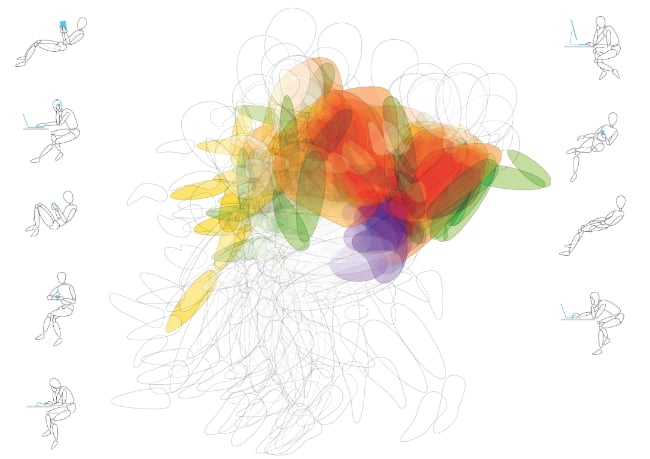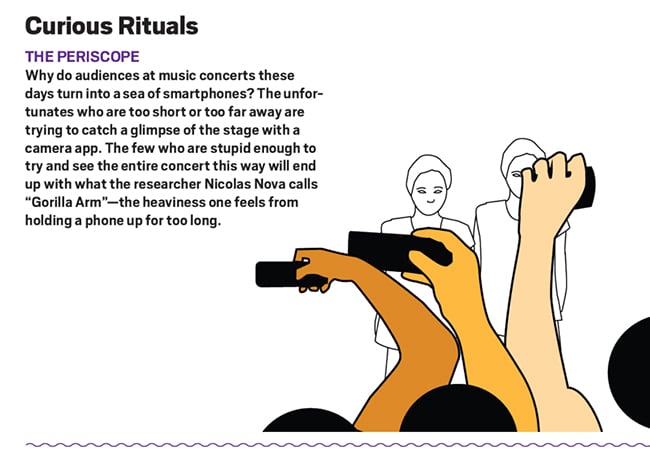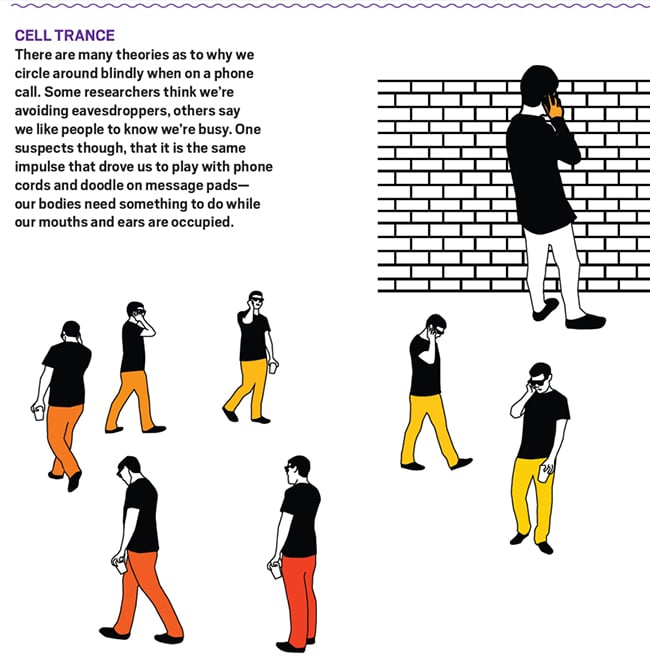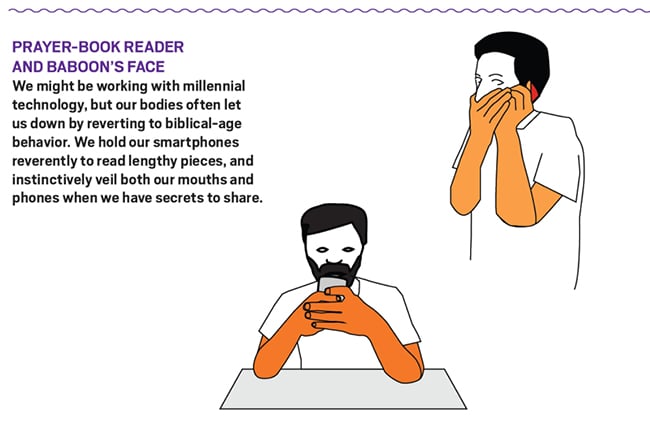
November 4, 2013
In This Age of Ubiquitous Computing, What Are We Doing to Our Bodies?
In this age of ubiquitous computing, what exactly are we doing to our bodies?

Courtesy Steelcase
I have a favorite Starbucks location that is my office away from my office. I try not to think too much about why crouching over my laptop and latte while perched on an uncomfortable bar stool is sometimes the most effective way of getting work done. All I know is that to-do lists evaporate when I’m in that caffeinated digital cocoon. And when my shoulders start to stiffen and my feet go to sleep—as they eventually do—I stretch and look up to catch the iPad user next to me trying out some neck flexes. We share a sympathetic smile.
There is clearly a disconnect between what the communications revolution allows us to do today and how enthusiastic our bodies are about doing it. History indicates that this kind of rift between technology and comfort should be like catnip for designers—ask the secretaries whose pain inspired Henry Dreyfuss’s 1960 study in ergonomics and anthropometric data, The Measure of Man: Human Factors in Design (Whitney Library of Design). Today, our fingers are furiously swiping and typing, our shoulders are hunched, our spines are curved, our necks are either bent over tiny screens or swiveling to catch the magnificent sweep of big ones, and we increasingly want to start doing these things earlier in life and keep doing them later in life. We continue to go wide-eyed at the release of each new smartphone and we want to use technology everywhere, with little thought for the physiological and cultural consequences. How can we learn to use our bodies more kindly in this new millennium?
The first step might be admitting that having on-the-go access to computing is not entirely a benign development. “Smartphones and tablets are not being used in place of traditional technology; people still have laptops, they have desktops,” says Jonathan Puleio, the director of consulting for ergonomics at the furniture manufacturer Humanscale. In recent times, there has been a cumulative effect of bad postures with both old and new technologies, leading to a surge in two specific ailments. The first is connected with the overuse of texting and touch-based devices: “a tendon-related disorder with the thumb, called de Quervain’s tenosynovitis, which involves the inflammation of the tendon sheath in the thumb. That disorder was called BlackBerry thumb,” he says. The second can be traced to too many screens being used in the lap or way below the comfortable eye-level— chiropractors are seeing an increase in spinal disc–related disorders called tech-neck. “I teach a course at NYU Polytechnic with a bunch of students who are engineers, and their necks are noticeably forward. Their walking postures have already altered,” Puleio says.
The more long-lasting consequences are the subconscious habits we have developed around technology. Our interaction with screens affects other objects—and people—in our environment. Last year, Nicolas Nova, a Geneva-based ethnographer, worked together with three students at the Art Center College of Design, Pasadena, to identify patterns in how people use digital technology. The resultant study, Curious Rituals, documents such involuntary acts as Cell Trance, where people talking on the phone wander around, often into the paths of others, and Lazy Viewer, the crazy positions we adopt on beds and couches to make late-night laptop use comfortable. This study promises to help designers and planners understand how users already have changed their patterns around smart devices. “After we did the project, my consultancy has been contacted by clients, to either apply those findings to their product design, or try to do something similar with their products,” Nova says. One such client was a group of urban planners who were designing a busy railway station. Being made aware of Cell Trance led them to design semi-private areas where people can wander about on their calls safely, without getting in the way of rush-hour commuters.

Illustrations by Katherine Miyake
That’s not all. Manufacturers are intertwining the fates of our bodies and our devices more and more deeply. At last year’s Consumer Electronics Show, Samsung showed a Smart TV that could be controlled by voice and hand movements. (“I did some user studies to see how people try to use that thing,” Nova says. “The gestures that people have to use are a bit absurd.”) Two months ago, the company unveiled its Galaxy Gear Smartwatch. “It will be interesting to see how people use the Samsung watch,” says Alan Hedge, a professor of ergonomics at Cornell University, and a leading expert in the field. “Supposedly you can make and receive phone calls on the device. Well, what’s the social situation of talking into your wrist, or putting your wrist up to your ear?” And that’s ignoring the fact that holding my wrist to my ear seems to flex both the shoulder and elbow at an angle that I couldn’t possibly hold for the duration of a long phone call.
Such awkward collisions of the digital and the physical show how ill-equipped designers are to deal with the range of possibilities that technology affords. This is because there is a deep divide between the skill sets they use to tackle each of the two realms. The designers of software and interfaces have relied on specialists in Human-Computer Interaction (HCI) to tell them how our eyes, fingertips, and brains process information, while industrial designers have traditionally turned to physical ergonomists for design guidelines and anthropometric data on how our limbs move and behave. These two things have rarely come together, partly because the design timelines are so different: “In the furniture world, it can take you several years to develop a product. In the digital world that’s the kiss of death,” Hedge says.

But come together they must. Over the last two years, Bruce Smith, the design director at Steelcase, commissioned a series of studies for his company, getting researchers all over the world to document how people actually behaved in work and public spaces. “The second phase of the study included smartphones and tablets, and there we were able to see some profoundly different postures,” he says. These observations were consolidated into a set of nine postures that workers customarily adopt with their laptops and tablets, and ultimately fed into the design of Steelcase’s Gesture chair.
“I can’t sit here and say that it was terribly scientific,” Smith admits, but like Nova’s Curious Rituals project, the Steelcase study brought new, more contextual understanding to the field, and might shake designers out of their apathy around ergonomics. In the past, masters like Herman Miller’s Bill Stumpf and Humanscale’s Niels Diffrient transformed design through their understanding of human behavior, but for many other designers it still means looking up how long most people’s legs are and deciding how deep the seat of a chair should be. “We can’t apply the same methods and techniques of the traditional contract furniture industry, and expect different results,” Puleio says. “For instance, the desk height of 29.5 inches, which has been a standard in the furniture industry for at least the last four decades, correlates to the seated elbow height of a six-foot-four tall male. By default, work surface heights are much too high for much of our workforce.” This poses an additional problem in the digital age: “Monitors are getting so large that when they are placed on this standard desk height, they’re too high even in their lowest position,” he says.
While overreliance on outdated data is dangerous, so is being too enthusiastic to adopt new research. Studies have shown, for instance, that sedentary work has longterm negative effects on our bodies. But in their enthusiasm for dynamic workspaces, designers have found solutions that either have very limited application, or, frankly, border on the absurd. “Things like the treadmill desk seem to make sense on one level,” Hedge says. “But they have been shown to have a detrimental effect on work performance, and also potentially pose a safety hazard for people who forget to walk.” Ultimately, the wisest solutions acknowledge that no one solution is perfect: The Norwegian furniture designer Peter Opsvik, who pioneered the idea of active furniture, used to say that the best posture was the next posture.

These ideas of pervasive technology and active work-places are fine goals for a fit, young workforce; they might prove more challenging as we inevitably age. This, as we have been warned time and again, is an urgent problem. In 2010, the U.S. Bureau of Labor Statistics estimated that one in five workers is over the age of 55; in 2020 the figure will be one in four workers. And that doesn’t just mean older desk jockeys learning to use Skype on an iPad. It will eventually mean, say, woodworkers of all ages operating computer-controlled machinery, factory workers of different abilities using smart interfaces on increasingly automated shop floors, and let’s not forget, older citizens navigating spaces where everyone is distracted by what they’re seeing with their Google Glass.
It’s an incredible stack of challenges. “How can we design places that accommodate these different generations, and how can we design places that we don’t base on technology, because that technology is going to change so rapidly?” Hedge asks. Nova believes we must start by breaking down the silo between software designers and hardware designers and start studying new patterns of behavior. Smith suggests that specialists from many related fields—psychologists, sociologists, even archaeologists—must bring their expertise to bear on the field of human factors, to help us understand why we behave the way we do. But ultimately, both of these initiatives will need to be infused with the rigor of older anthropometric studies. In Dreyfussian terms, we need to take the measure of digital human beings of all ages and abilities.

In doing this, we must not forget that we also live in the age of instant gratification. “Simple is not so simple, from a design standpoint,” Puleio says. “We’re putting a lot of our effort and development dollars into passive technologies—an example of that would be a chair that has a self-adjusting recline mechanism.” Convenience is key, especially as work spaces grow less formal, or move out of the office entirely. People are less and less likely to put bulky task chairs in their homes, where they might actually be doing as much work as in the office. But they are also less likely to invest time in learning to use products properly—an old complaint of ergonomists who were constantly exhorting us to sit straighter or rest our hands elsewhere. In an age where I download a new operating system for my phone and expect to immediately know how to use it, I have no patience for anything that doesn’t feel intuitively comfortable.
It’s obviously time to forget the crazy shapes of the keyboard supports of the early 1990s, as well as the knob-and-lever-operated sitting machines of the turn of the millennium. But our blandly cuboidal devices of today may not be the best idea for our bodies. We must apply Occam’s razor to ergonomic design. The creative breakthrough in the field will ultimately be when designers can bring the greatest comfort to the maximum number of people, in a variety of situations, in the simplest way possible. That was always the basic tenet of human-centered design, and one we would do well to recall in these tech-fetishistic days.
My Starbucks problem, of course, is still not solved. I’m tired of deciding whether the banquettes (deep low seats that force me to sit on the edge and lean forward) or the bar stools (high seats that have me slouching) will ultimately cause me less pain. So I decided to turn to the Internet. Lo and behold, the physical therapist Steve Meagher had a very helpful YouTube video on how I should sit on a pillow and prop my laptop on a ring binder to turn any old work surface into a comfortable environment. That works, for now. So until industrial designers, interface designers, HCI specialists, and ergonomists get their act together, I will be reduced to carrying a pillow and a binder to the coffee shop.





